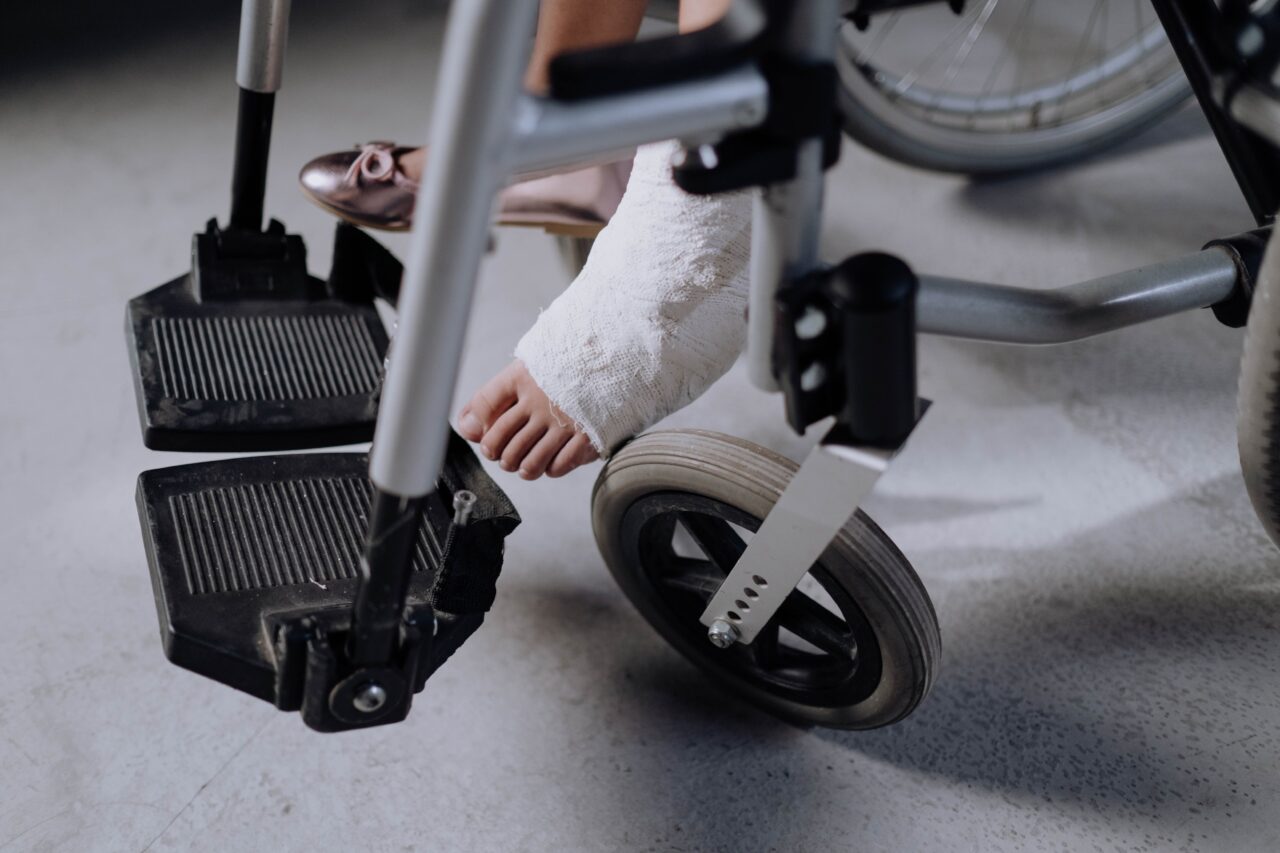Rose is a 72 year old widow living in the nursing home for the past 3 years with relatively little difficulty. She had a minor stroke a few years back which caused relatively minor neurologic damage on the left side of her body causing her to have a slight drag in that foot. At the same time she is on anti-coagulants and anti-hypertensives for her high blood pressure. Since the stroke she has slowed considerably from her fairly active lifestyle. Unfortunately, in the third year of her residency she has a fall resulting in some bad bruising. Two weeks later she has another. This time she goes to the hospital where she is diagnosed with a urinary tract infection for which she is medicated with antibiotics. Fortunately, the x-rays were negative for fracture. When she gets back to the nursing home after a 3 day admission in the hospital she rises from her seat in the dayroom during an activity session staggered a few steps and her left leg buckled. She fell. This time she fractured her pelvis. She underwent a surgery that required the use of three metal screws into her already brittle pelvis. Rose attempted physical therapy but never regained the same level of function, stopped attending activities and began spending considerably more time in bed. She eventually developed a sacral decubitus ulcer and from the inactivity and lying on her back. She also developed multiple bouts of pneumonia. She was dead within 10 months. This may sound outrageous but its a lot more common than you might think. In fact 4 percent of hip fracture patients die during their initial hospitalization; 24 percent die within a year of the injury; and 50 percent lose the ability to walk forever.
(Rodrigues J, Sattin R, Waxweiler R: Incidence of hip fractures, United States, 1970-83. Am J Prev Med 1989; 5:175-181. Ray N, Chan J, Thamer M, Melton L: Medical expenditures for treatment of osteoporotic fractures in the United States in 1995. Report from the National Osteoporosis Foundation, J Bone and Miner Res 1997; 12: 24-35. Wolinsky F, Fitzgerald J, Stump T: The effect of hip fracture on mortality, hospitalization and functional status: A prospective study. Am J of Public Health 1997; 87:398-403. )
Let’s talk about how to prevent scenarios like this. Here are some of the most common risk factors:
1) Gait dysfunction/muscle weakness
2) Previous falls
3) Alzheimer’s disease, parkinson’s, or other central nervous system disorders. I4) Blood pressure issues. W
5) Incontinence
6) Lack of exercise
7) Vision
8) Transfers.
9) Environmental hazards
10) The “tools” of walking (ex. correctly fitting shoes)
11) Medications
Once you have identified the risk factors associated with your loved one’s fall potential you are in a position to put into place an effective plan to minimize these risks. There are several tools available to the medical practitioner, assisted living/nursing home staff or even you if you are caring for an individual in your own home. The most important thing to remember is that we want a tailored approach. We want to identify risk factors and then reduce those specific risks. We don’t take a kitchen sink approach to fall prevention or really any other interventions we might implement for our elderly or frail loved ones. One of the reasons we don’t want to throw every intervention out there is because some interventions get in the way of others. For example, one intervention might be placing the residents’ bed in a low position with a mattress on the floor to prevent injury from falling out of bed. This can be an effective intervention if your resident is rolling out of bed but not nearly as effective if your loved one is getting up in the middle of the night due to urinary urgency to go to the bathroom and tripping on that mattress in the middle of the night! So remember, we identify a risk factor and we plan for that risk factor. I try to break interventions up into 4 distinct areas : environmental, medication adjustments, alarms, quasi restraints (belts, lap buddies, wedge cushions, and side rails).
Environmental – Make sure there are no tripping hazards for your loved one. Clear the clutter. Make sure when you visit you are paying attention to the pathways your loved one is most likely to traverse for example between bed and bathroom. You can also add handrails to walls, bathrooms, elevated toilets and the like. Anything to provide something for your loved one to grab onto if they lose their balance as well as the removal of anything that would impede your loved ones ability to have free movement. I would also put making sure eyeglasses are available and the like into this category. Likewise, falls out of bed can often be remedied by pushing one side of the bed against the wall thereby reducing the fall risk by 50%! On the other side of your resident is a riser in the middle of the night you could lower the bed and put a cushion or mattress on the floor thereby eliminating the risk of injury during sleeping hours. Again, remember it must be tailored to the resident.
Medication adjustments – If you are noticing disorientation, lethargy, balance issues, gait disturbances or the like, ALWAYS question the medications. There is often an optimal balance between fall risk and a medicine’s efficacy. Beware for drugs that help “keep the resident quiet” or “prevents acting out”. While I am not discussing restraints specifically here, a chemical restraint is any medication used primarily for the convenience of the staff. If your resident is slightly demented and finds humming oldies makes him or her happy, we really don’t want an increased fall risk to exist because staff is medicating the singing out them!! Know the medications your resident is on, the dosages and know what the extrapyramidal side effects are – in other words, ask your physicians whether any of these medications could be adjusted to control for fall risk without deleterious medical effects to the resident. Remember always that medications don’t stand alone. When you are prescribed five different medications you actually have a cocktail of all five of them inside your body. Often removing or changing the dose of just one of the medications has a profound effect on the other four! Learn about the medicines, examine how they would interact and be involved in the medication changes.
Alarms – There are dozens of types and brands of alarms from tab alarms, chair alarms, pad alarms, wanderguards, bed alarms, pressure alarms and the like. Some of them are pinned right to the residents clothing and the other end is connected to their chair so as soon as they rise from the seated position an alarm will sound. If your resident has a significant fall risk when rising due to postural hypotension or the like this can be a somewhat effective measure.
Reviewing prescribed medicines to assess their potential risks and benefits and to minimize use (Cooper 1994; Cooper 1997).
Providing patients with hip pads that can effectively prevent most hip fractures if a fall occurs (Kannus et al. 2000).
Using devices such as alarms that go off when patients try to get out of bed or move without help (Rubenstein et al. 1994).
Exercise programs can improve balance, strength, walking ability, and physical functioning among nursing home residents. However, it is unclear whether such programs can reduce falls (Nowalk et al. 2001; Vu et al. 2005).
RESTRAINTS
Routine use of restraints does not lower the risk of falls or fall injuries. They should NOT be used as a fall prevention strategy (Capezuti et al. 1996).
Restraints can actually add to the risk of fall-related injuries and deaths (Rubenstein et al. 1994). Limiting a patient’s freedom to move around leads to muscle weakness and reduces physical function (Rubenstein et al. 1997).
Since federal regulations took effect in 1990, nursing homes have reduced the use of physical restraints (Rubenstein et al. 1994). Some nursing homes have reported an increase in falls since the regulations took effect, but most have seen a drop in fall-related injuries (Ejaz et al. 1994).
If we can prevent falls BEFORE they happen, residents like Rose may not unnecessarily suffer a decreased quality of life and mental health decline as they age.



